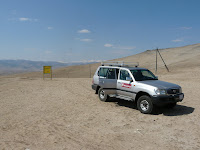Spring comes late to Mongolia. I walked down by the river this afternoon 26 April to look in scrub for migrants but there were few about. Black-eared kite, Daurian Redstart, Pine Bunting and White Wagtail. On my trip to countryside on 15 April wheatears were suddenly all over steppe, well the males any way, three species, isabelline, northern and desert and Black kite were overhead but. I have seen few migrants in and around UB, a dark phase booted eagle was notable.
The drive to Tetserleg was interesting; birding from a speeding landcruiser can be like a video game, a quick identification before the bird disappears. At first the flocks of larks were challenging. Mongolian lark was easy, a big long winged bird with a large wing panel (almost like a redshank) but nevertheless a frustrating way to see a new species, with no chance to check finer plumage details , or to be sure that none were the similar but in Mongolia scarce white winged lark. Similarly I assume the large herring type gulls were in fact Mongolian Gull but from landcruiser i was unable to check critical identification features. The plumage difference of other larks less obvious, but white trailing edge to secondaries was skylark, and I soon worked out the shore larks. There were short-toed larks but could have been one or all of three species
As well as the larks the journey was great for raptors. Black Vulture probably commonest raptor but also saw 1 griffon vulture, 2 rough legged and 8 or 9 Upland Buzzard, 1 Steppe Buzzard. In Tetsereleg I was delighted to get excellent views of goshawk. First in the evening flying up a valley and then the next day a huge female appeared from nowhere to take a Daurian jackdaw from a flock about 20 metres from me, it perched on the ground killing its prey for a few seconds before flying of. In southern England goshawk is a rare bird, and inexperienced birders often try to claim a sparrowhawk as a goshawk, but it really is one of those birds that when you see a goshawk it is so different from a sparrowhawk there is no doubt. I also saw hen harrier marsh harrier and I think a pied harrier but the view was not good enough to be sure it was not an eastern marsh harrier.
There has been a change in the jackdaws over the last month. In the first half of April most were almost white bellied adult Daurian, Then in Arkhangai the dark bird predominated, and now back in UB the dark first year birds predominate and most of the pale adult birds seem to have moved on.




